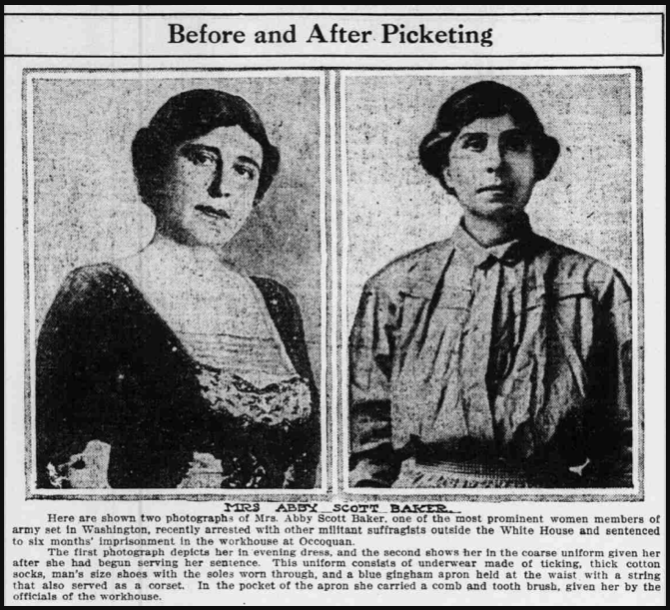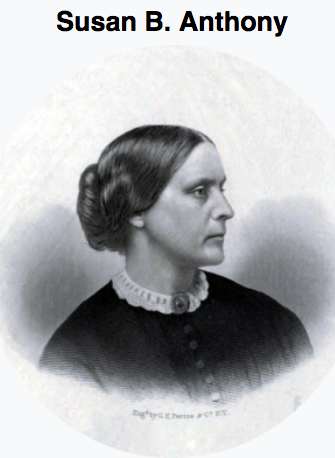
Hellraisers Journal, Thursday October 25, 1917
Occoquan Workhouse, Virginia – Photograph of Abby Scott Baker
From Indiana’s Richmond Palladium of October 22, 1917:
Here are shown two photographs of Mrs. Abby Scott Baker, one of the most prominent women members of army set in Washington, recently arrested with other militant suffragists outside the White House and sentenced to six months’ imprisonment in the workhouse at Occoquan.
The first photograph depicts her in evening dress, and the second shows her in the coarse uniform given her after she had begun serving her sentence. This uniform consists of underwear made of ticking, thick cotton socks, man’s size shoes with the soles worn through, and a blue gingham apron held at the waist with a string that also served as a corset. In the pocket of the apron she carried a comb and tooth brush, given her by the officials of the workhouse.
———-
DEBS REMEMBERS SUSAN B. ANTHONY
While the suffragists picketing the White House in Washington D. C. are being dragged off to jail, we offer this remembrance of Susan B. Anthony, whose long and unrelenting struggle for full citizenship these brave women carry on. The fond memorial tribute to Miss Anthony is gleaned from an article by Eugene V. Debs which appeared in the July 1917 edition of Pearson’s Magazine. (We urge our readers to seek out the entire article):
Susan B. Anthony: Pioneer of Freedom
by Eugene V. Debs[…..]
In February, 1879, I first met Miss Anthony personally. She was on a western lecture tour and came to Terre Haute to fill an engagement under the direction of a literary club with which I
then connected. I had always favored equal suffrage and had long admired Miss Anthony as the champion of her sex. From Lafayette I received a message from her asking me to meet her on arrival of her train. Instantly I recognized her as she stepped to the platform and I was proud and happy to escort her to her hotel. She impressed me at once as a woman of strong character and commanding personality. She was exceedingly kind and gracious in manner. She was dressed quietly without any attempt at style. It was apparent that she had little interest in the “latest in bonnets.” She had more serious business in mind.The prejudice against her in the community was bitter and relentless. In the eyes of the conservative, the respectable, the conventional, the reactionary, the great bulk that always stands for what is and against what is to be, and is ever ready to apply the branding iron to the thinker and tie the faggots to the feet of the reformer—in the eyes of these self-righteous and self-complacent people who have in every age been the enemy of progress and crucified the world’s saviors, or stoned or imprisoned or despised them, Susan B. Anthony was, of course, “unwomanly”—she was a “bold and brazen creature,” a positive offense to her sex. I felt it keenly on her account, but she did not seem to be even conscious of it. At least she gave no outward sign. She towered too far above her lilliputian detractors to be disquieted by their petty prejudices and their silly reproaches. She knew that they did not know enough to know she was their friend and deliverer in spite of themselves, and she pitied them accordingly.
Mrs. Ida Husted Harper, who then resided in Terre Haute, met Miss Anthony on this occasion for the first time. Mrs. Harper took an active part in arranging Miss Anthony’s meeting and this was the beginning of a friendship which ripened into an intimacy that ended only with Miss Anthony’s death [March 13, 1906]. Mrs. Harper became not only Miss Anthony’s confidential friend but her biographer as well, spending several years at the Anthony homestead collecting the material and writing the three large volumes comprising the Life and Work of Susan B. Anthony and covering practically the entire history of the suffrage movement in the United States.
Miss Anthony’s audience at Terre Haute was not large but her speech was great. She had an amazing array of facts and figures, but these were not dry or uninteresting to her listeners. She held them from first to last by her intense earnestness, her deep sincerity, the clarity of her reasoning, and the convincing force of her argument. She made it clear in that early day, when a female orator was still a freak or at least a curiosity, that a woman could be quite as much at home on a public platform as in a private kitchen. She disarmed prejudice and cleared the atmosphere for the more enlightened public sentiment which has since swept Indiana into the number of equal suffrage states.
Almost 25 years passed before I met Miss Anthony for the second and last time. It was in her home city of Rochester and this time she sat in the audience I addressed. The years of trial, persecution and incessant struggle had left their ruthless impress upon her noble features. She had reached four score, and the sands of life were slipping away. She waited until the close of the meeting and as I approached her she clasped my hands in both of hers. “You remember me?” she queried with the modesty so characteristic of her. “Remember you,” I answered, “how could anyone ever forget Susan B. Anthony?” The sweetest smile lighted up her venerable countenance as she pressed my hands and said, “How glad I am to see you after all these years!” We chatted about the days that were gone, about the progress that had been made, and about the work yet to be done. She laughingly remarked: “Give us suffrage and we’ll give you socialism,” to which I answered in the same spirit: “Give us socialism and we’ll give you suffrage.” She was not enthusiastic over the results of her work. I endeavored to reassure her but she gravely shook her head and was plainly disappointed that the half century of bitter struggle in which she bore so commanding and honorable a part had not been more fruitful of results and that she must pass away without realizing the fulfillment of her lifelong dream.
Soon after this Susan B. Anthony passed from earthly scenes to the realms of rest. Again I returned to Rochester to address another meeting. A mass of red roses and carnations decorated the stage. At the close of the meeting it was decided to visit Miss Anthony’s resting place and decorate her grave and the grave of her beloved sister and guardian angel, Mary, with the flowers. On the following morning under escort of the women comrades we repaired to the cemetery, covered the graves of “Aunt Susan” and “Sister Mary” with our red roses and carnations, and paid to their memory the tribute of our love and tears. We then visited the Anthony homestead and were shown from room to room, the once busy haunts that now seemed so strangely still.
I thought of the great woman, the luminous soul who had reigned in that historic and hospitable old home, of the many sacrifices she had made, the many burdens she had shouldered, the many lives she had touched, the many sleepers she had awakened, the many sorrows she had assuaged, the many prejudices she had dispelled, the many hopes she had inspired, the many obstacles she had overcome, the many crosses she had borne, the many pitiless persecutions she had suffered, the many battles she had fought, and the final glorious triumph which had crowned her noble life.
Susan B. Anthony lived for humanity and wrought for the ages. She made her name synonymous with the cause of human freedom and equal rights; she was a moral heroine, an apostle of progress, a herald of the coming day.
[Photograph added.]
SOURCES
The Richmond Palladium
(Richmond, Indiana)
-Oct 22, 1917
(Image: Suffragists Abby Scott Baker)
http://chroniclingamerica.loc.gov/lccn/sn86058226/1917-10-22/ed-1/seq-16/
Debs Internet Archive (Scroll down to 1917.)
Debs on Susan B Anthony from Pearson’s, July 1917
https://www.marxists.org/archive/debs/
IMAGE
Susan B Anthony, 1820-1906, wiki
https://en.wikipedia.org/wiki/Susan_B._Anthony
http://www.archive.org/stream/historyofwomansu01stanuoft#page/n603/mode/2up
See also:
Women of Protest: Photographs from the Records of the National Woman’s Party
https://www.loc.gov/teachers/classroommaterials/connections/women-protest/history3.html
Abby Scott Baker
https://en.wikipedia.org/wiki/Abby_Scott_Baker
Alice Paul
https://en.wikipedia.org/wiki/Alice_Paul
Lucy Burns
https://en.wikipedia.org/wiki/Lucy_Burns
“Women’s Suffrage Movement Led to Occoquan Workhouse Imprisonment”
-by Debbie Robison
http://www.novahistory.org/Lorton_Womens_Suffrage.htm
Workhouse Prison Museum at Lorton
http://workhousemuseums.org/
Night of Terror
http://nationalwomansparty.org/sample-second-post/
https://www.smore.com/j5963-night-of-terror-campus-campaign
http://www.truth-out.org/speakout/item/27182-night-of-terror-for-white-house-picketers-to-be-observed-on-november-15th
Ida Husted Harper
https://en.wikipedia.org/wiki/Ida_Husted_Harper


